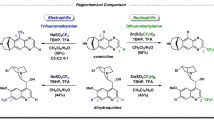Abstract
WE have recently determined the ultra-violet absorption spectrum of carefully purified carbonyl sulphide, using a quartz spectrograph and a hydrogen discharge tube as a source of light. The spectrum shows a continuous absorption starting from a sharp limit at λ = 2550 ± 20 A. and extending far towards the ultraviolet. This spectrum is interpreted as corresponding to the dissociation of the COS molecule, which was also indicated by the deposit of sulphur on the walls of the absorption tube. The products of dissociation may be CO and S, or CS and O. The energies of these processes as calculated from thermochemical data are :
This is a preview of subscription content, access via your institution
Access options
Subscribe to this journal
Receive 51 print issues and online access
$199.00 per year
only $3.90 per issue
Buy this article
- Purchase on Springer Link
- Instant access to full article PDF
Prices may be subject to local taxes which are calculated during checkout
Similar content being viewed by others
References
Christy and Naudé, Phys. Rev., 37, 907, 1931.
Author information
Authors and Affiliations
Rights and permissions
About this article
Cite this article
LOCHTE-HOLTGREVEN, W., BAWN, C. & EASTWOOD, E. Photochemical Dissociation of Carbonyl Sulphide. Nature 129, 869–870 (1932). https://doi.org/10.1038/129869c0
Issue Date:
DOI: https://doi.org/10.1038/129869c0
Comments
By submitting a comment you agree to abide by our Terms and Community Guidelines. If you find something abusive or that does not comply with our terms or guidelines please flag it as inappropriate.



